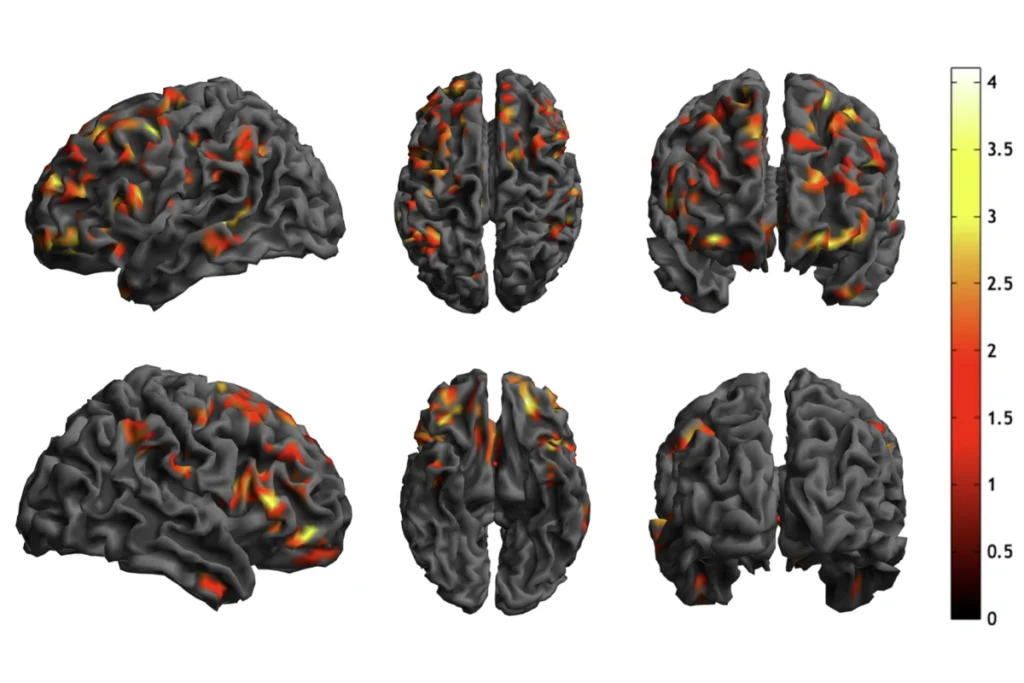The largest-yet single-cell genomics analysis reveals new details of the molecular pathways and cell types that are altered in the cortex in people with autism. The work, published last month in Science, also hints at how genes linked to the condition contribute to these brain differences.
The findings are part of a package of 14 new papers from PsychENCODE, a multi-institution consortium launched in 2015 to study the molecular basis of neuropsychiatric conditions. The initiative’s latest phase of research analyzed human brains at the single-cell level instead of relying on bulk tissue samples as in previous efforts.
“Single-cell analysis gives you the ability to really understand a condition in terms of cell-cell interactions, and how a condition might affect different cell types in very different ways,” says PsychENCODE chair Daniel Geschwind, professor of human genetics, neurology and psychiatry at the University of California, Los Angeles, who led the new autism study.
Past work by Geschwind and others identified a “molecular signature” in tissue samples of autism brains, characterized by increased expression of immune signaling genes, decreased activity of synaptic and neuronal genes, and a reduction in the regional gene-expression patterns typically seen across the cortex. The first single-cell analysis—involving cells from 15 autistic and 16 non-autistic people, and published in 2019—hinted at a role for microglia and excitatory neurons in layer 2/3 of the cortex.
The new study confirms these previous findings and expands autism’s molecular signature to include a subtype of interneurons and layer 5/6 excitatory neurons, which project to other cortical areas. It also adds gene-expression changes, such as heightened immune responses in oligodendrocytes, cells that help produce the myelin sheath insulating the central nervous system. “That suggests there may be something going on broadly with connectivity in autism,” Geschwind says.
The gene activity analyses involved nearly 600,000 cells from the frontal cortex of 33 autistic people and 30 non-autistic people, aged 2 to 60. “We were able to analyze all 26 major cell types in the cortex,” Geschwind says.
Transcription factors—many of which are encoded by genes strongly linked to autism—explain a large proportion of gene-expression changes within these cells, the study shows. “One of my models, which still stands, suggests there are many, many steps between risk genes and the gene-expression changes seen in autism,” Geschwind says. “But this single-cell data suggests there needn’t be so many steps.”
I
n a separate PsychENCODE study, Geschwind and other researchers investigated how the proportions of seven brain cell types differed across 31 autistic participants and 1,239 people with or without other neuropsychiatric diagnoses. Despite a great deal of research on the molecular basis of these conditions, “we know very little about the contributions of quantitative differences in cell types in neuropsychiatric diagnoses and across the lifespan,” says study investigator Chloe Yap, a clinician-scientist at the University of Queensland.People with autism have increased numbers of microglia, the findings suggest. “Microglia are the immune cells of the brain, so this finding supports the idea of neuroinflammation being relevant in autism,” Yap says.
It remains uncertain whether this difference is a cause or consequence of autism, Yap says. “Microglial shifts or neuroinflammation could be due to conditions that commonly co-occur with autism and impact upon neurodevelopment, such as sleep problems, anxiety, stress or developmental delay,” she explains. To help pick apart cause or consequence in this case, “we need bigger datasets where other clinical data has been collected, such as sleep problems or developmental delay, which could also explain the increase in microglia.”
In a third PsychENCODE study, an independent team looked at differences in genetic activity in brain samples from 2,160 adults with autism, bipolar disorder or schizophrenia. Women with any of these conditions displayed a larger number of changes in gene expression compared with men—in support of the existence of a “female protective effect,” the researchers wrote in their paper. That theory suggests that girls and women are somehow more resistant to factors that predispose someone to autism and other conditions and therefore require a higher genetic and environmental load to develop such conditions.
“That discovery was possible because of PsychENCODE pulling all these diverse samples together and harmonizing their data so we can merge and analyze them,” Geschwind says.
All these findings hold the hope that scientists will one day be able to analyze cell-type-specific changes to sort autism into more genetically defined subtypes, “which can further be used as a basis of developing personalized therapies,” says Dmitry Velmeshev, assistant professor of neurobiology at Duke University, who was not involved in any of the new work.
Future research can analyze still more people, genes and regions of the brain “to help us understand how what we see molecularly relates to a patient’s phenotype, and to give us more confidence that what we see is generalizable,” Geschwind says.
Postmortem samples cannot reveal how people might have changed over time, so future studies should also use as many different models as possible, such as mice and organoids, “integrating them to provide a full picture,” says Gaia Novarino, professor of neuroscience at the Institute of Science and Technology Austria, who was not involved in the new work. “This new collection of material is providing very good new data to follow up on, with research that can shed light on how conditions alter developmental trajectories.”






